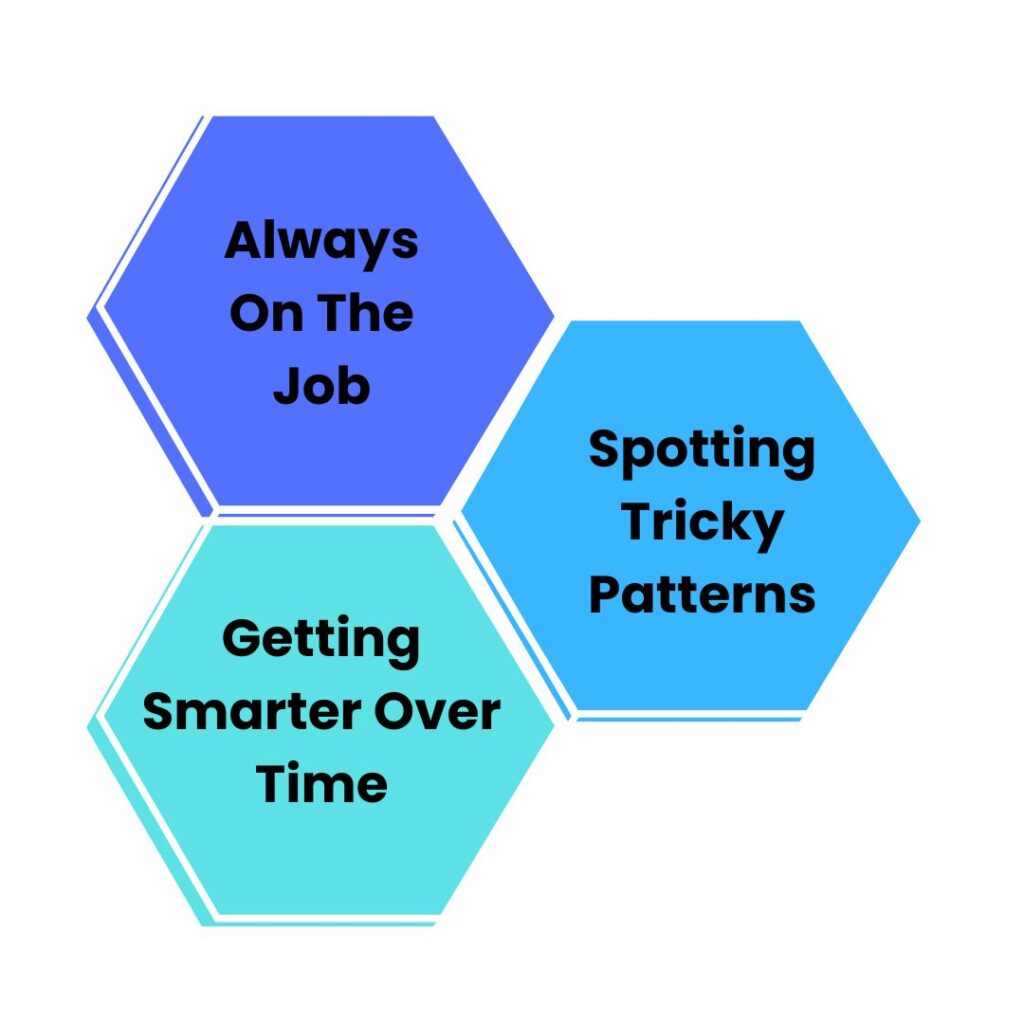In today’s digital world, fraud has become a major concern for businesses and individuals. As scammers get smarter, we need better ways to catch them. This is where AI in fraud detection comes into play.
AI is changing how we spot and stop fraud. It’s like having a super-smart helper that can quickly notice when something fishy is going on. This technology is making it harder for fraudsters to trick us.
In this blog, we’ll explore how AI helps fight fraud, its different uses, and some strategies to prevent scams. Whether you’re a business owner or just curious, you’ll learn how AI is making our digital world safer.
Table of Contents
- What is AI in Fraud Detection?
- The Role of AI in Fraud Detection
- Common Uses of AI in Fraud Detection
- How AI Detects Fraud
- AI-Powered Fraud Prevention Strategies
- Real-World Examples of AI in Fraud Detection
- Conclusion
What is AI in Fraud Detection?

AI in fraud detection is like having a smart digital detective working around the clock to spot suspicious activities. It uses computer programs that can learn and think in ways similar to humans, but much faster and on a larger scale.
Unlike old-fashioned fraud detection methods that rely on set rules, AI can adapt and improve over time. It learns from past fraud cases to get better at spotting new tricks that scammers might try.
Think of it as a vigilant guard dog for your financial transactions. Just as a dog can smell something off before you notice it, AI can detect odd patterns in data that might signal fraud before it becomes a big problem.
The Role of AI in Fraud Detection

AI plays a big role in keeping our money and information safe from fraudsters. Let’s look at how it helps:
Always On The Job
AI doesn’t sleep or take breaks. It watches over transactions 24/7, ready to spot anything fishy at any time. This non-stop monitoring means it can catch fraud as it happens, not after the damage is done.
Spotting Tricky Patterns
AI is great at finding patterns that humans might miss. It can look at loads of data and notice when something doesn’t fit the usual picture. This helps catch sneaky fraud attempts that might fool regular systems.
Getting Smarter Over Time
One of the coolest things about AI is that it learns from experience. Every time it sees a new fraud trick, it remembers it. This means it gets better and better at catching fraud as time goes on.
AI doesn’t replace human experts, though. Instead, it works with them. AI can flag suspicious activities, and then human investigators can take a closer look. This teamwork between AI and humans makes fraud detection stronger than ever before.
Common Uses of AI in Fraud Detection

AI helps fight fraud in many areas of our daily lives. Here are some common ways it’s used:
1. Credit Card Protection
AI watches your credit card spending. If it sees a purchase that doesn’t match your usual habits, it can flag it as possible fraud.
2. Keeping Insurance Fair
When people make insurance claims, AI checks if they’re honest. It looks for signs that someone might be trying to get money they don’t deserve.
3. Guarding Against Identity Theft
AI can spot when someone tries to use your personal information. It checks things like login attempts and account changes to make sure it’s really you.
4. Making Online Shopping Safer
When you buy stuff online, AI works in the background. It checks for fake websites and suspicious transactions to keep your money safe.
How AI Detects Fraud
AI uses smart techniques to catch fraudsters. Here’s how it works:
- Data Analysis: AI looks at tons of information quickly. It can spot odd patterns that humans might miss.
- Machine Learning: This is like AI’s way of learning from experience. It gets better at spotting fraud over time as it sees more examples.
- Anomaly Detection: AI knows what “normal” looks like. When something unusual happens, it raises a red flag for further checking.
AI-Powered Fraud Prevention Strategies
AI doesn’t just catch fraud; it also helps prevent it. Here are some ways:
Strategy 1: Biometric Checks
AI can use things like your fingerprint or face to make sure it’s really you. This makes it harder for fraudsters to pretend to be you.
Strategy 2: Behavior Analysis
AI learns how you normally use your accounts. If something strange happens, it can ask for extra proof that it’s you.
Strategy 3: Network Watching
AI can see how different accounts are connected. This helps it spot organized fraud rings.
Real-World Examples of AI in Fraud Detection
Let’s look at how AI is actually helping in the real world:
1. Banking
A big bank used AI to check credit card transactions. It caught $2 billion in fraud in just one year.
2. Online Shopping
A popular e-commerce site uses AI to spot fake reviews. This helps customers trust the products they’re buying.
3. Insurance
An insurance company used AI to look at claim photos. It found $60 million in false claims by spotting edited pictures.
4. Government Services
A state government used AI to check tax returns. It caught $millions in fraudulent refund claims.
These examples show how AI is making a real difference in protecting people and businesses from fraud.
Conclusion
In conclusion, AI in fraud detection is changing the game in our fight against scammers. This smart technology works tirelessly to spot and stop fraud in many areas of our lives, from online shopping to banking.
By learning from experience and spotting unusual patterns, AI helps keep our money and information safer. While it’s not perfect, AI in fraud detection is a powerful tool that works alongside human experts. As fraudsters get cleverer, AI keeps getting smarter too.
For businesses and individuals alike, embracing AI could be the key to staying one step ahead of fraud in our digital world.


2 thoughts on “AI in Fraud Detection: Role, Uses & Prevention Strategies”